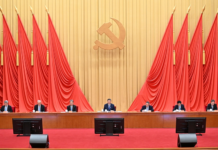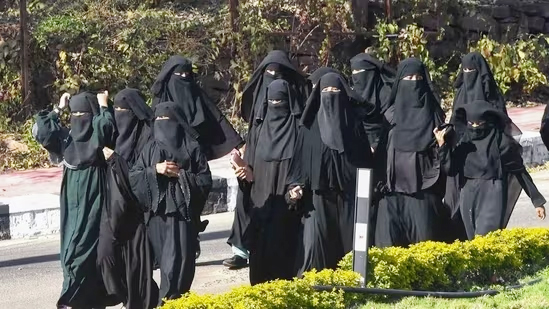The Ram temple consecration ceremony is due on January 22. The temple is being built on the site of the Babri mosque demolished by a mob, led by BJP leader L.K. Advani (all culprits acquitted). The Bharatiya Janata Party and its mentor, the Rashtriya Swayamsevak Sangh, are determined to take maximum advantage from the event. They have their eyes on elections to 11 Lok Sabha seats.
The Congress initially condemned Modi’s effort to politicize the consecration ceremony, a religious ritual. But, later, a group of senior Congress leaders visited the incomplete temple to show solidarity with fanatical Hindus. The RSS has warned Muslims too to chant “Jai Shri Ram” (Long Live Lord Ram) on January 22 .
Modi proceeded on an 11-day fast and performed worship at an Andhra Pradesh temple related to the Ram-Ravan-Sita story. He wants to convince the electorate that he is a devout defender of the Hindu Rashtra. Construction of the Ram temple is enshrined in the BJP’s manifesto.
The socio-economic condition of the Indian Muslim, like that of the dalit, has worsened over the years. The golden words of the Indian Constitution about fundamental rights, justice liberty, equality and fraternity (Articles 25 to 30 in Part III of the Indian Constitution) remain unfulfilled. Preventing cow slaughter or the eating of beef has neither economic nor constitutional backing. Dr Subramanian Swamy, a member of the Rajya Sabha (Upper House of Indian Parliament) has filed a writ petition to get the words “secularism” deleted from the Preamble to the Indian Constitution
The Ram temple frenzy caricatures “secular” provisions in the Indian Constitution. All minorities are persecuted in diverse ways. During riots in the North East, churches were desecrated. Christian missionaries are hounded out of India. The dalits (downtrodden; Sudras) are meted out inhuman treatment.
The Muslim remains the most persecuted minority. India’s Supreme Court held a mosque was inessential to the Muslim manner of worship. Even those offering prayer in open space were lynched. Loudspeaker can’t be used to say azan.
The cow is worshipped. Beef eaters are lynched. India’s National Crime Records Bureau withheld collected data on murders; burning Muslims alive, cow-related lynching and offences committed for religious reasons.
Yogi Adityanath, saffron chief minister of India’s most populous state, Uttar Pradesh, equated cows with human beings. The Uttarakhand Legislative Assembly passed a resolution for “declaration of the cow as Rashtra mata, national mother.”
Muslims and dalits run cow slaughter and small-scale beef trade. To deprive the beef-eating minority of a cheap source of food, Uttar Pradesh Hindu-monk chief minister Adityanath launches a crackdown on them from time to time.. He directed his administration to book the “offenders” under India’s National Security Act. Simultaneously, he approved an ordinance to increase the penalty for cow slaughter up to 10 years imprisonment and a fine up to Rs 500,000.
Justice Mahesh Chandra Sharma of Rajasthan High Court urged the Centre to declare the cow India’s national animal and recommended life imprisonment for cow slaughter. A “Hindu religious assembly” exhorted people to arm themselves with the latest weapons to carry out Muslim genocide.
There is a hue and cry in India that the Muslim population may outnumber the current Hindu majority before long. The fanatic Hindus point out that Islam, unlike Hinduism, allows polygamy. As such, a Muslim household is likely to have more siblings than a Hindu. The BJP wants to enforce a uniform Civil Code that outlaws polygamy.
Not all the projections about the phenomenal growth of the Muslim population may be correct. Above all, the Muslim population in India has always been under-represented in the Lok Sabha. Pew Research Center estimated that there were 195 million Muslims in 2015. By 2060, Pew estimates, there will be more Muslims in India than anywhere else in the world (outnumbering even Indonesia), and they will constitute 19 percent of Indians.
Riaz Hassan, in his study Indian Muslim: Sociology of a religious Minority infers:
The largest and most consequential change [in population] however will be in India. Its Hindu population will increase by 35 percent from 1.03 billion in 2010 to 1.38 billion in 2050, but Indian Muslim population will increase by 76 cent from 176 million to 310 million in the same period. This means that the largest increase in the Muslim population of South Asia will occur in India.
“India will acquire a new global status in terms of the religious composition of its population. Not only will it be the largest Hindu nation but also with a population of 310 Muslims, India will become the largest Muslim nation in the world. While Hindus will remain the majority population at 77 percent, the proportion of Muslims will increase from 14 percent of the population in 2011 to 18 percent in 2050. This means that nearly one out of every five Indians will be a Muslim.”
Unlike the Christians who have their chief minister in a Christian-majority Indian state, The Indian Muslims have no chief minister. Even the Indian-held Kashmir state has been illegally converted into a centrally controlled Union territory.
But, dispersal of Indian Muslim population is disadvantageous. Indian Muslims live in all parts of the country, but more than half of them live in Uttar Pradesh, Bihar, Assam, West Bengal, and Kashmir.
Muslims have always been underrepresented in the Lok Sabha. In the 1980 election, almost 10 percent of those elected were Muslim. In 2014, it was less than four percent.
As the result of poor representation in the Lok Sabha, critical questions about the plight of the Muslim in India are never asked. Most questions about Islam are usually asked by the Hindu legislators. These questions revolve around rituals like hajj. Few questions are asked about the plight of the Indian Muslim women, for instance harassment of hijab-wearing women at public places. The number of Muslim women is less than one percent of the Lok Sabha.
The majoritarian policies of the BJP are likely to further reduce Muslim representation. Many Hindu nationalists express the idea that Muslims can never be truly Indians because, unlike Hindus, their holy sites are not in India. The BJP’s growth was catalyzed by the demolition of the Babri Masjid in 1992. In the 2002 riots, over 1000 people, most of whom were Muslims, were killed in the state of Gujarat (Modi was then the state’s chief minister).
The Sachar Committee highlighted the social marginalisation of the downtrodden Muslims.
The Committee observed: “Their [Muslims’] conditions are only slightly better than those of Hindu Scheduled Castes/scheduled Tribes and worse than those of Hindus belonging to other backward castes [read Mandal Report also]”.
Sachar Committee found that their identity marks such as addresses and names often lead to suspicion and discrimination by people and institutions. Discriminations are persuasive in employment, housing and schooling. Muslim women who wear religious head and face covering can experience particularly acute discrimination. At the same time, most of the fellow non-Muslim fellow citizens regard the socio-cultural characteristics of the Muslim community as the cause of its “backwardness”.
The socio-economic condition of the Indian Muslim, like that of the dalit, has worsened over the years. The golden words of the Indian Constitution about fundamental rights, justice liberty, equality and fraternity (Articles 25 to 30 in Part III of the Indian Constitution) remain unfulfilled. Preventing cow slaughter or the eating of beef has neither economic nor constitutional backing. Dr Subramanian Swamy, a member of the Rajya Sabha (Upper House of Indian Parliament) has filed a writ petition to get the words “secularism” deleted from the Preamble to the Indian Constitution.
Where is secular India headed?























